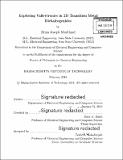Exploring valleytronics in 2D transition metal dichalcogenides
Author(s)
Modtland, Brian Joseph
DownloadFull printable version (22.21Mb)
Other Contributors
Massachusetts Institute of Technology. Department of Electrical Engineering and Computer Science.
Advisor
Marc A. Baldo.
Terms of use
Metadata
Show full item recordAbstract
Monolayer transition metal dichalcogenides (TMDs) exhibit distinct electrical and optical properties according to the relative occupation of each of two valleys in their dispersion relation. The resulting valley degree of freedom is robust, linked to a large spin-orbit splitting between valence bands, and shows promise in electro-optical devices or as an information token for logic applications. In order to explore applications of these properties, monolayer crystals are required that have reduced intervalley scattering. To date, the majority of valley-related studies have focused on exfoliated samples for their quality and ease of production. In this thesis, valley polarization is explored in monolayer tungsten disulfide (WS₂) synthesized by chemical vapor transport (CVT). This novel method of bottom-up growth relies on halide-driven vapor transport commonly utilized in bulk crystal growth. Using a small amount of sodium chloride salt as a source of chlorine, non-volatile WS₂ can react to form gaseous tungsten chloride and sulfur. With an open tube system, a controlled reaction generates mono- and few- layer WS₂ crystals. These crystals have excellent optical properties and exhibit a degree of valley polarization near 50% at 77 K and up to 30% at room temperature. This surpasses previous values reported in WS₂ . By decoupling pump photon and thermal energy, valley depolarization shows the characteristics of an electron-hole exchange interaction rather than nonradiative scattering. These results offer the initial groundwork for future devices that use the coupled valley-spin degree of freedom as a robust token of information, promising reduced power consumption compared to conventional MOSFET-based electronics.
Description
Thesis: Ph. D., Massachusetts Institute of Technology, Department of Electrical Engineering and Computer Science, 2018. Cataloged from PDF version of thesis. Includes bibliographical references (pages 129-144).
Date issued
2018Department
Massachusetts Institute of Technology. Department of Electrical Engineering and Computer SciencePublisher
Massachusetts Institute of Technology
Keywords
Electrical Engineering and Computer Science.